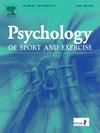Tracking every bite and step: Associations between diet and fitness app use, disordered eating, body image concern and compulsive exercise
IF 3.3
2区 心理学
Q2 HOSPITALITY, LEISURE, SPORT & TOURISM
引用次数: 0
Abstract
Background
Diet and fitness applications (apps) aim to enhance users’ physical health. Many of these apps allow users to monitor their diet or fitness-related data, such as the number of calories consumed or burnt. However, they may not be suitable for all individuals due to their focus on dietary restriction and weight loss.
Objectives
The present study sought to determine whether the use of specific app types (e.g., diet versus fitness) differ in their associations with disordered eating, body dissatisfaction, and compulsive exercise. Fit-ideal internalisation and exercise motivations were examined as moderating and mediating factors, respectively. An online questionnaire was administered to 386 Australian women (17–35 years).
Results
Diet monitoring app users and those who used both fitness and diet apps had greater disordered eating, body dissatisfaction, and compulsive exercise compared to fitness monitoring app users and non-users. Fit-ideal internalisation moderated the relationship between diet and fitness monitoring app use and disordered eating. Exercise motivations mediated the relationships between diet and fitness monitoring app use and disordered eating symptomology.
Conclusions
Despite diet and fitness apps’ intentions to promote health and wellbeing, their use is linked to disordered eating symptomology. Educating app users, screening for unhealthy behaviours within apps, and advising professionals how to monitor app use could provide suitable interventions to encourage more positive app use. In addition, more research is needed to determine associations in other understudied and at-risk populations such as adolescents, as well as longitudinal and experimental studies to establish directions of effects.
追踪每一口和每一步:饮食和健身应用程序使用、饮食失调、身体形象担忧和强迫性锻炼之间的联系。
背景:饮食和健身应用(app)旨在增强用户的身体健康。其中许多应用程序允许用户监控他们的饮食或健身相关数据,例如消耗或燃烧的卡路里数量。然而,它们可能并不适合所有人,因为它们关注的是饮食限制和减肥。目的和方法:本研究旨在确定特定应用类型(例如,饮食与健身)的使用是否与饮食失调、身体不满和强迫性运动有不同的关联。健康理想内化和运动动机分别作为调节和中介因素进行了研究。对386名17-35岁的澳大利亚女性进行了在线问卷调查。结果:与健身监测应用的用户和非用户相比,饮食监测应用的用户和同时使用健身和饮食应用的人有更大的饮食失调、对身体不满和强迫性运动。理想健康内化调节了饮食和健康监测应用程序使用与饮食失调之间的关系。运动动机介导了饮食和健康监测应用程序使用与饮食失调症状之间的关系。结论:尽管饮食和健身应用程序的目的是促进健康和福祉,但它们的使用与饮食失调的症状有关。教育应用程序用户,筛查应用程序中的不健康行为,并建议专业人员如何监控应用程序的使用,可以提供适当的干预措施,以鼓励更积极地使用应用程序。此外,需要更多的研究来确定其他未充分研究和高危人群(如青少年)的关联,以及纵向和实验研究以确定影响方向。
本文章由计算机程序翻译,如有差异,请以英文原文为准。
求助全文
约1分钟内获得全文
求助全文
来源期刊
CiteScore
6.40
自引率
5.90%
发文量
172
审稿时长
69 days
期刊介绍:
Psychology of Sport and Exercise is an international forum for scholarly reports in the psychology of sport and exercise, broadly defined. The journal is open to the use of diverse methodological approaches. Manuscripts that will be considered for publication will present results from high quality empirical research, systematic reviews, meta-analyses, commentaries concerning already published PSE papers or topics of general interest for PSE readers, protocol papers for trials, and reports of professional practice (which will need to demonstrate academic rigour and go beyond mere description). The CONSORT guidelines consort-statement need to be followed for protocol papers for trials; authors should present a flow diagramme and attach with their cover letter the CONSORT checklist. For meta-analysis, the PRISMA prisma-statement guidelines should be followed; authors should present a flow diagramme and attach with their cover letter the PRISMA checklist. For systematic reviews it is recommended that the PRISMA guidelines are followed, although it is not compulsory. Authors interested in submitting replications of published studies need to contact the Editors-in-Chief before they start their replication. We are not interested in manuscripts that aim to test the psychometric properties of an existing scale from English to another language, unless new validation methods are used which address previously unanswered research questions.

 求助内容:
求助内容: 应助结果提醒方式:
应助结果提醒方式:


